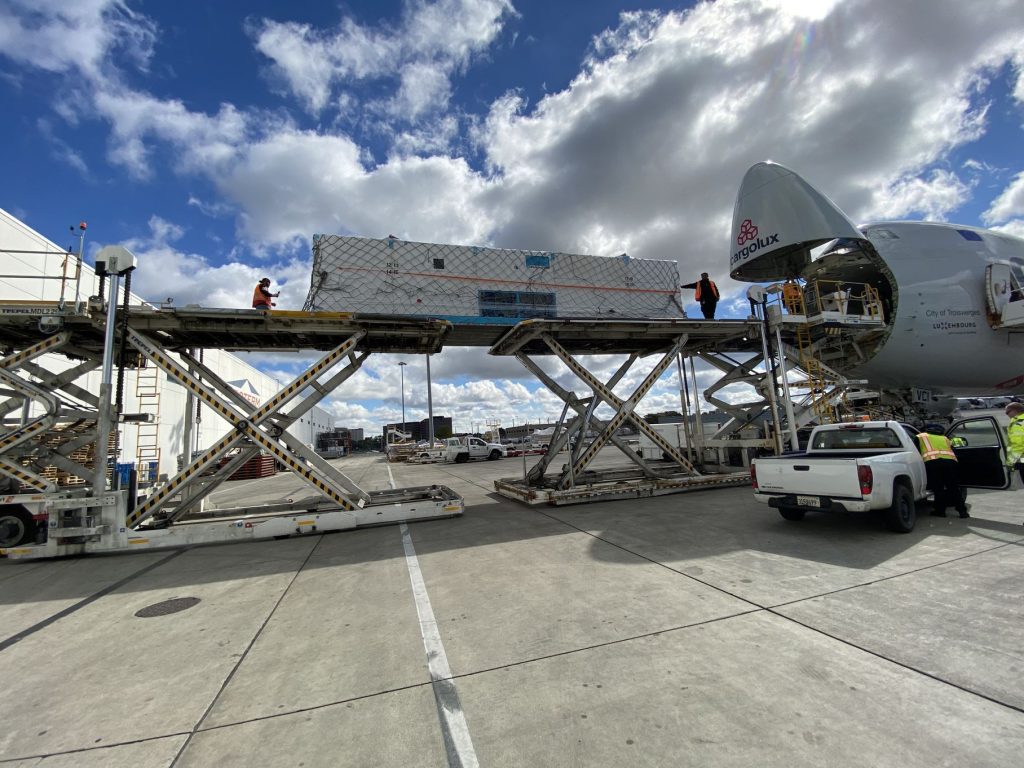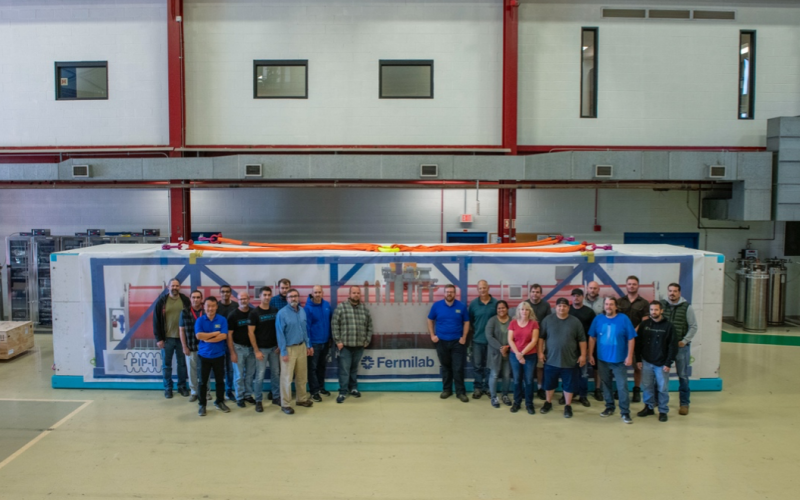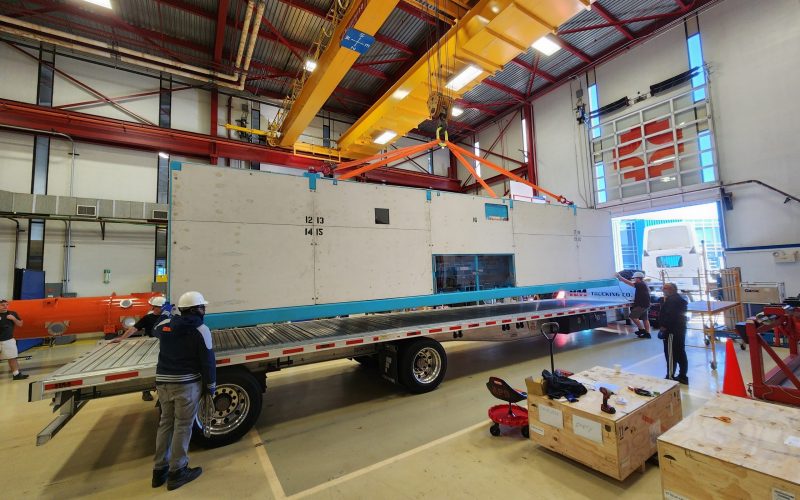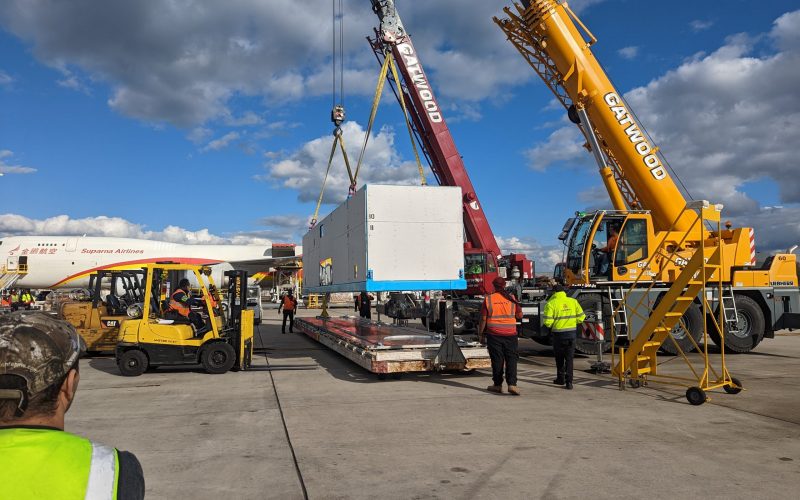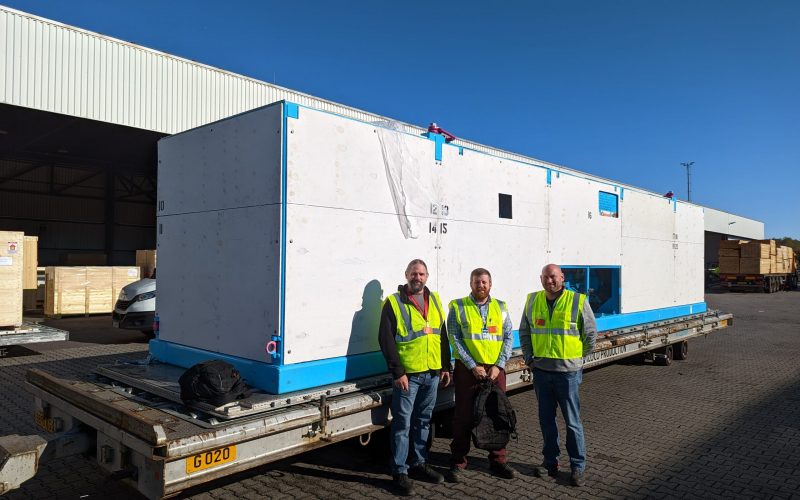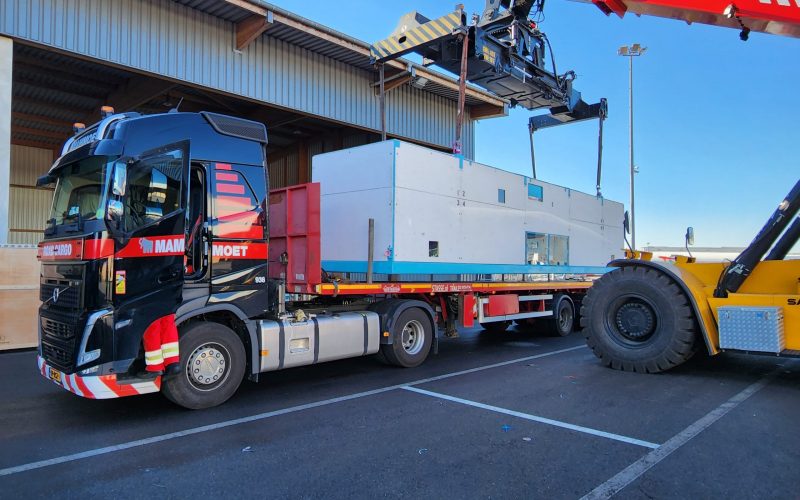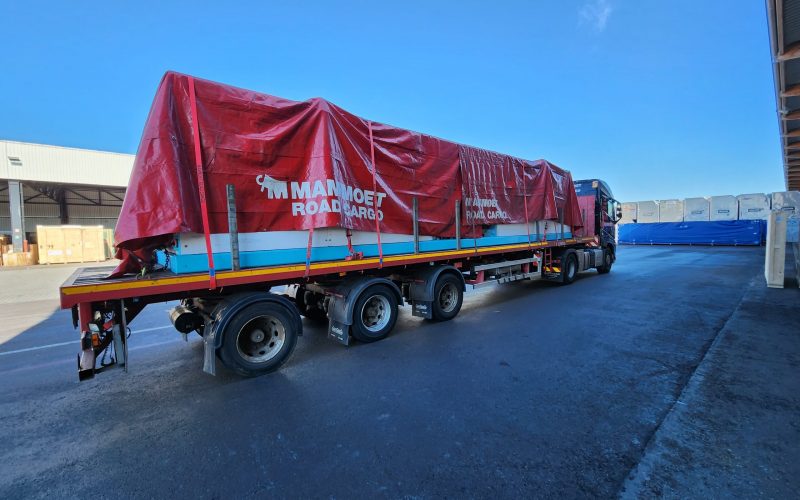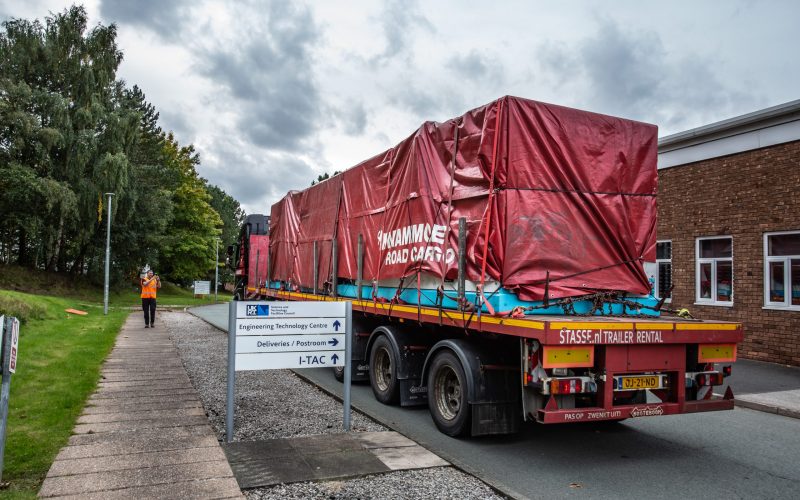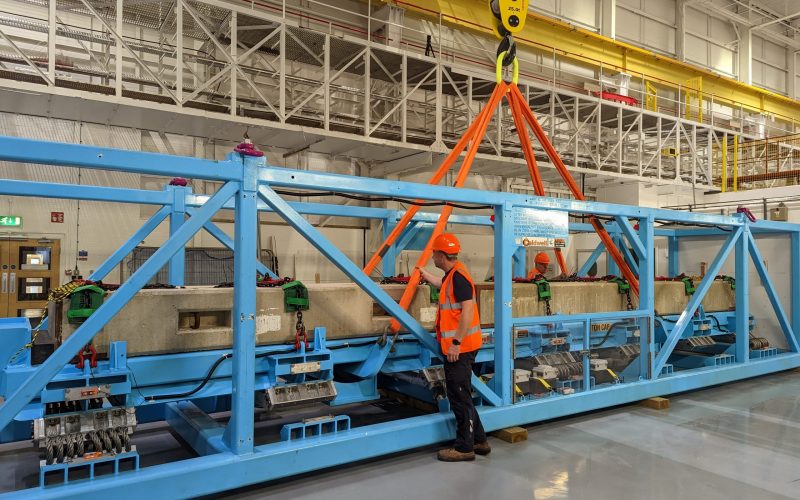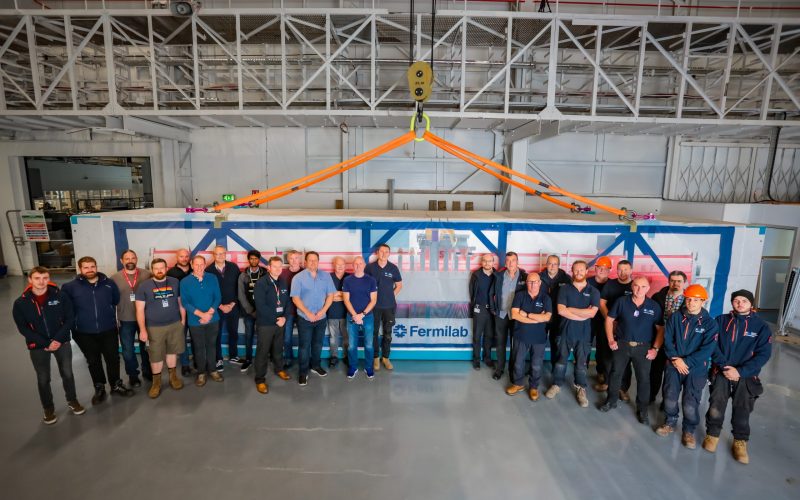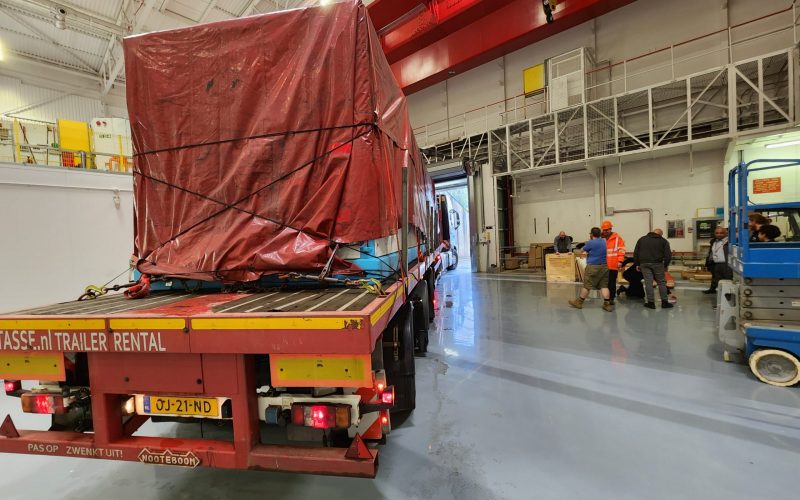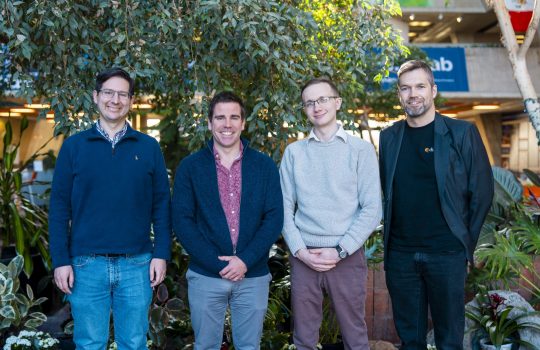The world’s most powerful neutrino beam is one step closer to becoming a reality. The Proton Improvement Plan II, or PIP-II, project reached a milestone in October when it successfully performed a transportation test of a “dummy load” between the U.S. Department of Energy’s Fermi National Accelerator Laboratory outside of Chicago and Daresbury Laboratory in England, outside of Liverpool. The test validated the system researchers will use to ship the delicate cryomodules that will make up a large part of a new linear proton accelerator at Fermilab. The new machine will power the production of neutrinos for the Deep Underground Neutrino Experiment.
Members of the international PIP-II collaboration from the United Kingdom, France and India will develop, manufacture and assemble cryomodules needed for the project, scheduled for completion in 2028. To ensure that the completed cryomodules will safely reach Fermilab, the PIP-II team is conducting extensive transportation tests well in advance.
For the first test earlier this year, PIP-II collaborators assembled a transportation frame that will be the blueprint for the eventual cryomodule transportation frame and test-drove it on a highway. The PIP-II team at the Science and Technology Facilities Council of UK Research and Innovation, or STFC UKRI, with input from Fermilab, led the frame’s design.
For testing purposes, the team loaded the frame with a cryomodule analog called a dummy load: concrete blocks with the dimensions, weight and mounting points of the actual cryomodule, which will be 10 meters long and weigh 27,500 pounds, or 12,500 kilograms.
First test flight
The latest test — the frame’s first transatlantic voyage — began on Sept. 23 at Fermilab’s Industrial Center Building in Batavia, Illinois. There, the team installed the dummy load and secured it inside the transportation frame, just as a cryomodule would be. They also outfitted the system with sensors to capture shocks observed during the test.
On Sept. 26, the frame left Fermilab in Batavia and traveled via trailer to Chicago’s O’Hare International Airport. Two days later, it was loaded onto a cargo plane and departed for Luxembourg; Luxembourg Airport is headquarters and hub for a cargo transportation airline, so all cargo flights must first pass through the small country. At Luxembourg Airport, several members of the Fermilab PIP-II team met the frame. Using a large crane, they off-loaded it from the plane and then lifted it onto a truck’s trailer, covering it in a tarp for its road trip to the United Kingdom, which departed on Sept. 30.
“The successful validation of the transportation frame using the dummy load is a testament to the dedicated international collaboration that comprises PIP-II.” – Saravan Chandrasekaran
After a lengthy road trip, including passage through the Channel Tunnel, the frame reached Daresbury Laboratory, a research lab located near Liverpool and operated by STFC UKRI, on Oct. 3. PIP-II partners removed the panels and dummy load from the frame and examined the sensors, bumpers, springs and other hardware. After checking all components, they reassembled the transport system, loaded it onto the truck and sent it on its way back to Fermilab on Oct. 5. The dummy load arrived back in Batavia, Illinois, on Oct. 11.
Signs of a successful collaboration
“I would call this an unqualified success,” said Jeremiah Holzbauer, the PIP-II transportation sub-project manager at Fermilab. “Everything went just about as well as we could hope for.”
Jon Lewis, project manager for the STFC contribution to PIP-II, agreed. “This is a significant de-risking exercise for us — and a real test of the frame designed by Mitchell Kane from our Projects and Mechanical Engineering group,” he said. “It’s also great to be able to host our Fermilab colleagues at Daresbury Laboratory once again. Working closely with Jeremiah Holzbauer, Adam Wixson and Ryan Thiede has reinforced our working relationship between the two labs.”
Saravan Chandrasekaran, technical manager for the PIP-II 650-MHz cryomodule at Fermilab, said, “The successful validation of the transportation frame using the dummy load is a testament to the dedicated international collaboration that comprises PIP-II.”
The team performed the test using procedures, techniques and oversight that were as realistic as possible. From the isolation system and vibration instrumentation to handling, logistics and customs, the test closely mimicked what the real cryomodules will go through during transportation. The good news: All aspects of the transportation system were deemed validated by this test.
PIP-II’s next step is to use the same frame to ship a complex prototype cryomodule, now in assembly at Fermilab, to the UK and back. Testing the prototype before shipment, while at STFC UKRI, and after its return will demonstrate that the transport process can protect these delicate systems during the long transport. This test is currently planned for early 2023.
In a few years, STFC will ship the production cryomodules in their own transportation frame to Fermilab for the construction of PIP-II.
“The strong collaborative program we have with Fermilab for STFC’s delivery of superconducting cryomodules for PIP-II relies massively on our ability to safely transport these highly complex and fragile systems over an extremely long distance,” said Peter McIntosh, STFC UKRI technical coordinator for PIP-II and deputy director of the Accelerator Scence and Technology Centre at STFC’s Daresbury Laboratory. “The transport frame that we have developed is critical for ensuring we can provide sufficient protection.
“This recent transportation test has not only provided important evidence for how shock loads have been effectively suppressed, but it has also allowed the Daresbury teams to verify many of the local logistics procedures,” McIntosh said. “This first assessment will prove incredibly important for when the next major validation is performed.”
Follow the journey
Fermi National Accelerator Laboratory is supported by the Office of Science of the U.S. Department of Energy. The Office of Science is the single largest supporter of basic research in the physical sciences in the United States and is working to address some of the most pressing challenges of our time. For more information, please visit science.energy.gov.

